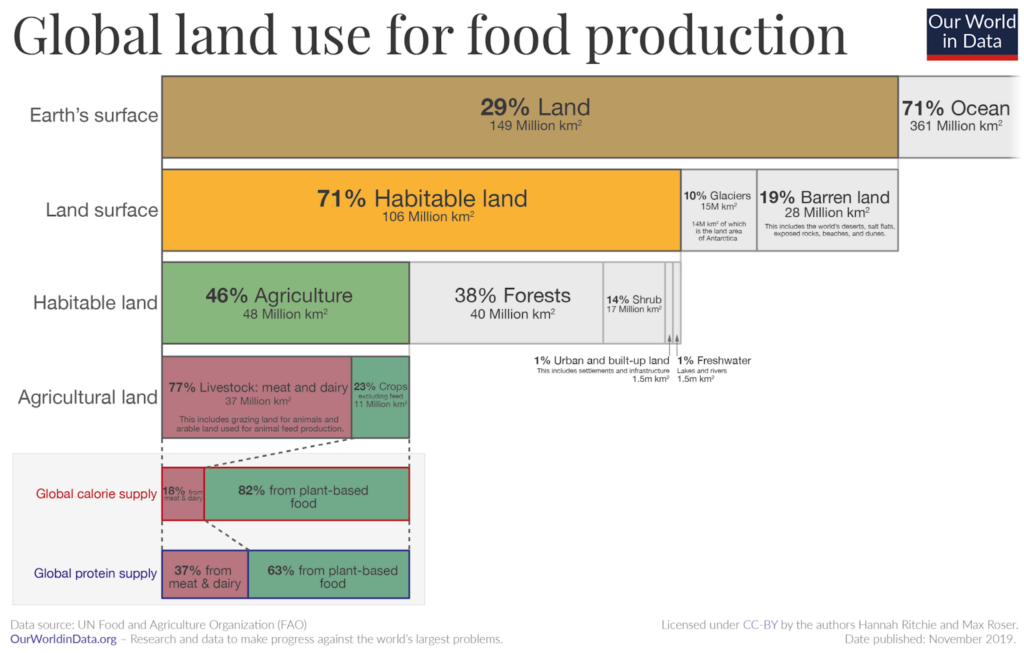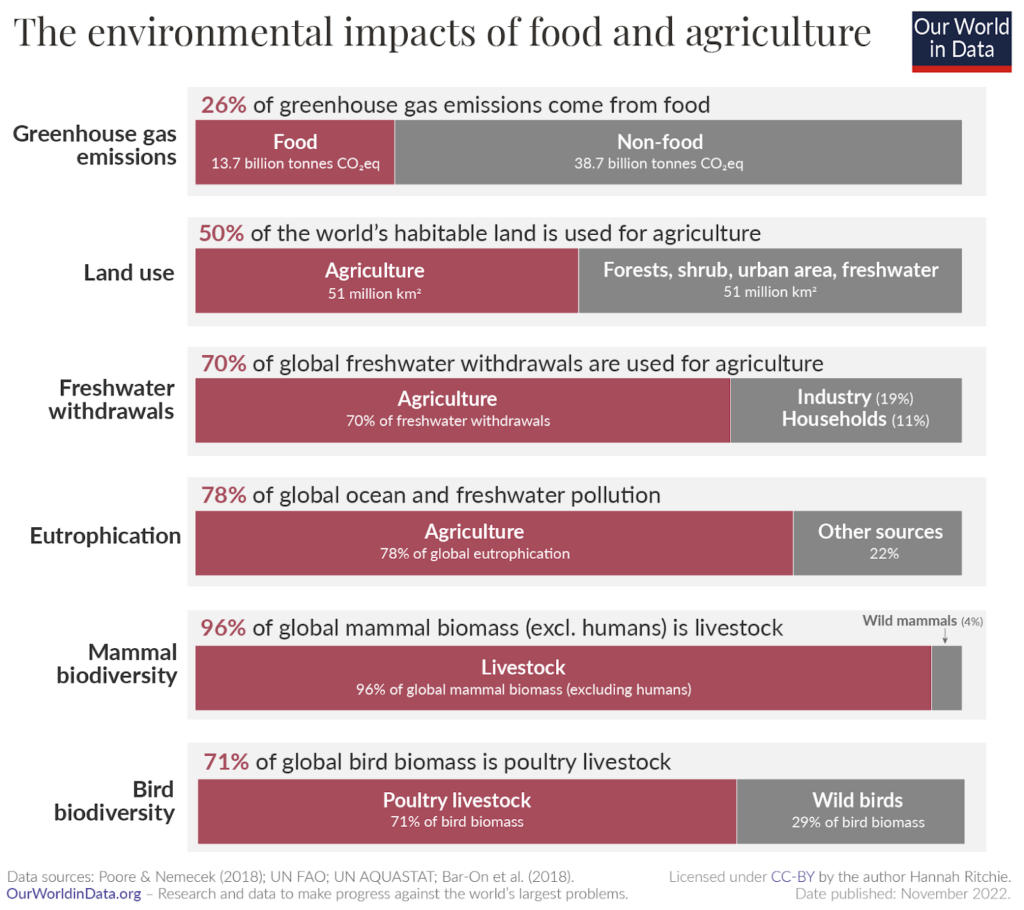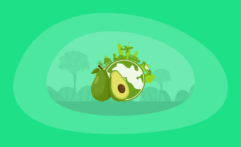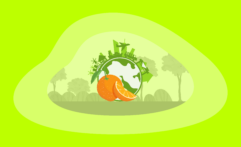The Environmental Impact of Cherries: From Farm to Table
Impactful Ninja is reader-supported. When you buy through links on our site, we may earn an affiliate commission.
Learn more
Learn more
.
Hey fellow impactful ninja ? You may have noticed that Impactful Ninja is all about providing helpful information to make a positive impact on the world and society. And that we love to link back to where we found all the information for each of our posts. Most of these links are informational-based for you to check out their primary sources with one click. But some of these links are so-called "affiliate links" to products that we recommend. First and foremost, because we believe that they add value to you. For example, when we wrote a post about the environmental impact of long showers, we came across an EPA recommendation to use WaterSense showerheads. So we linked to where you can find them. Or, for many of our posts, we also link to our favorite books on that topic so that you can get a much more holistic overview than one single blog post could provide. And when there is an affiliate program for these products, we sign up for it. For example, as Amazon Associates, we earn from qualifying purchases. First, and most importantly, we still only recommend products that we believe add value for you. When you buy something through one of our affiliate links, we may earn a small commission - but at no additional costs to you. And when you buy something through a link that is not an affiliate link, we won’t receive any commission but we’ll still be happy to have helped you. When we find products that we believe add value to you and the seller has an affiliate program, we sign up for it. When you buy something through one of our affiliate links, we may earn a small commission (at no extra costs to you). And at this point in time, all money is reinvested in sharing the most helpful content with you. This includes all operating costs for running this site and the content creation itself. You may have noticed by the way Impactful Ninja is operated that money is not the driving factor behind it. It is a passion project of mine and I love to share helpful information with you to make a positive impact on the world and society. However, it's a project in that I invest a lot of time and also quite some money. Eventually, my dream is to one day turn this passion project into my full-time job and provide even more helpful information. But that's still a long time to go. Stay impactful,Affiliate Disclosure
Why do we add these product links?
What do these affiliate links mean for you?
What do these affiliate links mean for us?
What does this mean for me personally?
![]()
Cherries are a staple fruit in everything from pies to mixed drinks. Their blossoms draw millions of crowds to public parks every spring, especially in Japan. They’re healthy too—a cup of cherries provides 3 grams of fiber and 1.4 grams of protein. But cherries can also have a negative effect on the environment. So we had to ask: What is the environmental impact of cherries?
Cherries have a minimally negative impact on the environment. The negative aspects mainly come from their use of pesticides, monoculture farming methods, and irrigation requirements. However, cherry trees have high carbon sequestering abilities and fertilize the soil when grown.
In this article, we will examine the environmental impact of cherries from several different angles. We will go through the life-cycle of cherries, detailing their impact on the environment from growth to distribution to your plate to waste management. We will then compare the environmental impact of cherries to that of other fruits. And, finally, we’ll share some tips with you on how you can reduce your own environmental impact and offset your own carbon emissions – both for your personal life and cherries-related.
Here’s How We Assessed the Environmental Impact of Cherries
The Environmental Impact Assessment (EIA) is one of the ways we measure the potential environmental effects of our actions, like the consumption of cherries. It is a holistic assessment based on the environmental changes associated with our consumption. Those are changes in our environment that can have adverse effects on the air, land, water, fish, and wildlife or the inhabitants of the ecosystem.
“Environmental Impact: the effect that the activities of people and businesses have on the environment”
Cambridge Dictionary
Basically, all goods and services you buy – including cherries – leave an impact on our environment. When it comes to food in general, and cherries in specific, the following are key factors:
- Land requirements: Large parts of the world that were once covered by forests and wildlands are now used for agriculture. 10 million hectares of forest are destroyed annually and 50% of the world’s habitable land is now used for agriculture. This loss of natural habitat has been the main driver for reducing the world’s biodiversity.
- Water footprint: 70% of global freshwater is now used for agricultural purposes. By assessing the water footprint of a particular food, we can determine how our limited freshwater resources are being consumed and polluted.
- Pesticide and fertilizer usage: Pesticides and fertilizers provide a range of agricultural benefits. However, numerous studies link pesticides and fertilizers to serious effects on human health, along with disruptions to vital ecosystems and the spread of aquatic dead zones.
- Carbon footprint: The carbon footprint is one of the ways we measure the effects of our human-induced global climate change. Today, food production accounts for over a quarter (26%) of global greenhouse gas emissions.
- Waste generation: Food and its packaging account for almost 45% of the materials landfilled in the US alone. And packaging sent to landfills, especially when made from plastics, does not degrade quickly or, in some cases, at all.
To understand the overall environmental impact of cherries, we must assess each of their key factors. This Environmental Impact Assessment (EIA) is a tool originally developed to identify the environmental impacts of a project prior to decision-making and also helps us to evaluate the environmental impacts of cherries, from farm to table.
Here’s the Overall Environmental Impact of Cherries
The overall environmental impact of cherries is minimally negative. The main environmental impacts come from high agrochemical use, occasional use of monoculture farming, and irrigation. Overall, their environmental impact is lower than other fruits.
Cherries have some positives when it comes to their environmental impact. Some of their more positive impacts include using polyculture farming sometimes, and being involved in reforestation projects around the world. They do, however, still have some negative impacts.
So, let’s have a look at the environmental impact of each key factor of cherries!
| Key Assessment Factors | Environmental Impact |
| Land requirements for cherries | Cherries’ land requirements are fairly high. This is mainly because of their high pesticide use and monoculture farming, in some cases. This means that their land use has a moderately negative environmental impact. |
| Water footprint of cherries | Cherries have a very low water footprint of 35 inches of water a year. They can, however, have a negative impact considering they use a high amount of pesticides and irrigation, when grown in California. |
| Agrochemical usage for cherries | Cherries’ agrochemical use is high. This is made worse by the fact that they use highly polluting nitrogen fertilizers. |
| Carbon footprint of cherries | The carbon footprint of cherries is fairly low at 0.19kg (0.41 lb) of CO2e per pound of cherries. This is mainly caused by their high pesticide use, low-density farming, and significant plastic packaging. Their carbon footprint is medium to low compared to other fruits. |
| Waste generation of cherries | Cherries’ waste generation is high. This is mainly due to their plastic packaging and low composting rates. |
These are the overall summaries, but there is a lot more to the story. In the next few sections, we will dive deeper into each stage to illustrate to you all the important aspects of cherries’ environmental impact.
What Are the Land Requirements for Cherries
Cherries’ land requirements are fairly high. This Is mainly because of their high pesticide use and monoculture farming, in some cases. This means that their land use has a moderately negative environmental impact.

Growing cherries has a lot of variables that contribute to their environmental impact. The amount of land they use, the way in which they grow, and the amount of time they take to grow will all contribute to their environmental impact.
How do the land requirements of cherries impact their environmental footprint?
- What is the land usage of cherries: Cherries yield around 9.5 tons per hectare. This is a fairly low yield amongst fruits. For example, strawberries and mangoes both yield up to 20–25 tons per hectare and bananas and pineapples both yield up to 100 tons per hectare. As a result, each ton of cherries needs more land to produce them, which can potentially lead to more resources and land being needed for cherry farms. This increases their consumption and therefore raises their environmental impact.
- Where and how are cherries grown: Most of the world’s cherries are grown in Turkey and the US. Cherries are grown on trees in orchards. Cherry trees have been found to be very effective at sequestering carbon, with each cherry tree being able to store up to 2.4 tons of carbon. Carbon sequestering helps to capture carbon from the atmosphere and store it in the ground, thereby lowering cherries’ carbon footprint and thus their environmental impact. Cherries are grown in both mixed farms and monocultures. Monocultures are terrible for biodiversity as they limit pollination, soil microbes, and other wildlife. Thus, cherries have a minimally negative environmental impact at this stage, unless they come from monoculture farms.
- How does the growing of cherries affect soil fertility and erosion: Cherry trees don’t cause significant damage to soil. In fact, cherry trees have been used in efforts to revitalize desert landscapes, making the ground more fertile as they grow. In this sense, cherries actually have a positive environmental impact.
- How does the cherries industry affect the loss of habitable land: Cherries don’t significantly impact habitable land. This is because cherries often grow very well with the soil. Their higher pesticide use, however, can harm soil and groundwater.
- How does the cherries industry affect wildlife and biodiversity: Cherries generally have a positive impact on wildlife. They have been known to offer habitats for wildlife in many environments. However, if they are grown in monocultures, then they will have a potentially damaging effect on biodiversity. They also have high pesticide use, which can potentially damage wildlife.
In short, cherries have a minimally negative impact on the environment, mainly due to their high use of pesticides and occasional monoculture farming practices.
What Is the Water Footprint of Cherries
Cherries have a very low water footprint of 35 inches of water a year. They can, however, have a negative impact considering they use a high amount of pesticides and irrigation, when grown in California.
Water usage is one of the most important factors in the environmental impact of a fruit. The amount of water used, as well as the way they affect the water sources around them, are all major contributing factors. Here, we will look at these different angles to cherries’ water impact.
How does the water footprint of cherries impact their environmental footprint?
- What is the overall water usage of cherries: Cherry trees need about 35 inches of water a year. This is a very low water requirement amongst fruits. For example, watermelons need as much as 100 inches of water a year.
- What is the green water footprint of cherries: The green water footprint is the amount of water from precipitation stored in the soil and used by plants for growth. Most cherries consumed in the US are grown on the west coast in California, Oregon, and Washington. Washington and Oregon get between 75 and 100 inches of precipitation a year. This means that only a small portion of their water is going towards cherries’ water requirements. California, however, only gets around 22 inches of rain per year. Thus, all the rain in the area will go towards irrigating California cherries. For this reason, Oregon/Washington-grown cherries have a far smaller green carbon footprint than California-grown cherries.
- What is the blue water footprint of cherries: The blue water footprint is the amount of water sourced from surface (such as rivers or lakes) or groundwater resources. The blue water footprint of cherries depends on their state. Oregon and Washington cherries don’t need irrigation, since both states get enough rain to meet their required 35 inches of water per year. California cherries, however, don’t get enough rainfall to cover their requirements and so they need considerable irrigation. Irrigation has several negative environmental effects, including causing groundwater imbalances and salinating nearby lands. Therefore, their blue water footprint is high in California, but low in Oregon and Washington.
- What is the gray water footprint of cherries: The gray water footprint is the amount of freshwater required to clean up water pollution to meet certain quality standards. Essentially, it’s the amount of water needed to make polluted water clean enough to be safe and healthy for humans and the environment. Cherries have very high pesticide usage. Therefore, they will need a considerable amount of water to clean up this residue, significantly raising their gray water footprint.
- How does the cherry industry affect freshwater and ocean pollution: The fact that cherries use a significant amount of pesticides means that they affect freshwater considerably. Pesticides get into groundwater and freshwater, which is harmful both to humans and aquatic life.
In short, cherries’ high use of pesticides and irrigation requirements, depending on where they are grown, amount to a moderate water footprint.
What Is the Agrochemical Usage for Cherries
Cherries’ agrochemical use is high. This is made worse by the fact that they use highly polluting nitrogen fertilizers.
Pesticides and fertilizers are agrochemicals that can have a significant impact on the environment. They both require resources to create as well as have effects on the life around them. Here, we will look at how cherries’ pesticide and fertilizer rates affect their environmental impact.
How does the agrochemical usage of cherries impact their environmental footprint?
- What is the pesticide usage of cherries: Cherries have considerably high pesticide usage. Significant pesticide traces have been found on 91% of cherry surfaces. Pesticides have a very negative environmental impact. They not only have adverse effects on groundwater, but they can also impact wildlife, insect populations, and soil microbes. This means that cherries’ environmental impact is very negative in terms of pesticide use.
- What is the fertilizer usage of cherries: Cherries typically use equal parts potassium, phosphorus, and nitrogen as fertilizer. Potassium has a fairly minimal environmental impact. Nitrogen fertilizers, however, have very negative environmental impacts, such as the release of nitrous oxide and damage to waterways.
- Are there any known issues connected to the agrochemical usage for cherries: Nitrogen is a particularly dangerous fertilizer. It can cause invasive algae growth which is harmful to ecosystems.
In short, cherries’ use of excessive pesticides as well as nitrogen fertilizer means that their agrochemical footprint is very high.
What Is the Carbon Footprint of Cherries
The carbon footprint of cherries is fairly low at 0.19kg (0.41 lb) of CO2e per pound of cherries. This is mainly caused by their high pesticide use, lower-density farming, and significant plastic packaging. Their carbon footprint is medium to low compared to other fruits.

Carbon footprint is one aspect of the overall environmental impact of a fruit. It essentially measures how much carbon or other greenhouse gasses the production of cherries emits into the atmosphere. Emissions from product manufacturing, irrigation, transportation fuel, and landfills all add up to create the overall carbon footprint of a fruit. Let’s see how the carbon footprint of cherries breaks down and contributes to their environmental impact.
How does the carbon footprint of cherries impact their environmental footprint?
- What is the overall carbon footprint of cherries: The overall carbon footprint of cherries is 0.19kg (0.41 lb) of CO2e per pound of cherries. This means that for every pound of cherries produced, 0.19kg of carbon is released into the atmosphere. This is a fairly low carbon footprint compared to other fruits.
- What are the main contributors to the carbon footprint of cherries: The main factors that contribute to cherries’ carbon footprint are their use of plastic packaging, above-average pesticide use, and lower-density orchards compared to many other fruits.
- Which life-cycle stage of cherries has the highest carbon footprint: The stage that contributes the most to cherries’ carbon footprint is harvesting, processing, and packaging. This is due to their mechanized processing and plastic packaging.
In short, cherries have a fairly low carbon footprint compared to other fruits. Though they still cause emissions through plastic packaging and pesticide use.
What Is the Waste Generation of Cherries
Cherries’ waste generation is high. This is mainly due to their plastic packaging and low composting rates.
When fruit waste, either packaging or organic materials, is disposed of, it can have a major impact on the environment. Whether it’s damaging wildlife, getting into oceans, emitting methane, or dissolving into microplastics that contaminate groundwater, all these materials have their part to play. In this section, we will look at how cherries’ waste affects the environment.
How does the waste generation of cherries impact their environmental footprint?
- What is the packaging of cherries: The most common types of cherry packaging are cardboard boxes, clamshell plastic tins, and plastic zip bags. Plastic production has a very negative environmental impact during its production process, polluting the environment, creating harmful chemical emissions, and using fossil fuels. Cardboard, though better than plastic, still contributes to deforestation.
- How is the packaging of cherries disposed of: Most of the materials used to package cherries can be recycled, but recycling rates tell a different story. On the one hand, there’s cardboard, which has a very high recycling rate of 89%. Plastic, however, has a very low recycling rate of 9%. Plastic is particularly bad because it acts as a major pollutant after it is disposed of, especially when it ends up in landfills or the ocean. One major problem associated with plastic is microplastics, which are particularly harmful to soil and groundwater.
- How are cherries disposed of: Cherries have pits and stems that generally aren’t eaten. They can also produce a significant amount of food waste because of their low shelf life of only 3–7 days. Cherries can be composted, but they usually aren’t in practice. In fact, food waste generally has a very low composting rate of around 4%. Landfills cause general environmental damage, but food waste takes it a step further by generating methane when it is put in landfills. For this reason, cherries can do a lot of damage when not composted.
In short, cherries have a high amount of packaging and organic waste. Due to the nature of their waste, they tend to contribute significantly to landfills.
What Have Been Historical Environmental Issues Connected to the Cherries Industry
The cherry industry has historically been somewhat bad for the environment. Their occasional monoculture farming and pesticide use has been damaging to lands and waterways.
All fruits have had a complex road toward global distribution. They originate in one part of the world and often travel far to end up in your local supermarket. From farm to table, some of our favorite fruits have racked up some serious environmental damage along the way. Whether it’s deforestation to meet demand, water pollution, or disruption of wildlife, most fruits have left a path of destruction. Let’s see how cherries have fared throughout history.
What have been the key environmental issues of the cherries industry?
- How much land has been lost because of cherry production: Cherries haven’t historically been associated with major land loss. In fact, they have been involved in many land restoration and diversification efforts. They are sometimes planted in polyculture orchards which has helped them avoid major damage to land.
- Which wildlife species have been negatively impacted or displaced because of cherry production: Though cherries aren’t as damaging to land as other fruits, especially because they aren’t always planted in monocultures, they are still sometimes planted that way. Monocultures have long been associated with biodiversity loss, which can affect every part of the food chain. Their high use of pesticides has also been harmful to wildlife. Therefore, over the years monoculture cherry farms have contributed negatively to wildlife.
- Have water sources and soil been contaminated because of cherry production: Cherries have used excessive amounts of pesticides through the years. These can cause a lot of damage to waterways and have been growing in damage over the last few decades. In a 2020 study, it was found that 10–25% of water sources were now contaminated with pesticides.
In short, cherries have damaged the environment in many different ways over the years, mainly due to their high use of pesticides and monoculture farming.
What Is the Overall Environmental Impact of Food and Agriculture
Food production in general has a high environmental impact. Everything from the amount of land used to the energy involved in irrigation to its effect on plant and animal biodiversity can be a factor in this. In the chart below, you can see how food production is one of the biggest influences on these areas of the environment.

Agriculture alone accounts for over a quarter of global greenhouse gas emissions, while using half of the world’s habitable land and 70% of the global freshwater withdrawals. Agriculture also causes 78% of the global ocean and freshwater pollution.
Livestock accounts for the vast majority of non-human mammal and bird biomass. Mammal livestock outweighs wild mammals by a factor of 15-to-1, and poultry livestock outweighs wild birds by a factor of more than 3-to-1.
These statistics highlight the need for sustainable and responsible practices in food production to reduce its impact on the environment. And the need for us to shift toward more environmentally-friendly foods.
How Can You Reduce Your Environmental Impact and Offset Your Personal Carbon Footprint
There are a few things you can do to mitigate some of the negative environmental effects of consuming cherries, while still enjoying them. You can also consider offsetting your personal and cherries-related carbon emissions, which work to remove carbon emissions elsewhere that are then attributed to you. Here, we will walk you through how to accomplish both of these things.
How Can You Reduce Your Environmental Impact When Shopping for Cherries
In this section, we give you a short list of ways you can reduce the negative environmental effects of cherries, based on those parts of the life-cycle of cherries that would otherwise most negatively impact the environment:
- Avoid plastic packaging: Many cherries come with plastic packaging. However, it is much better for the environment to choose cherries with no packaging or cardboard packaging. Cardboard packaging is more widely recycled, and so less of it will end up in landfills. Mitigating landfill contribution is essential for reducing your negative environmental impact.
- Buy domestic cherries: Although there are lots of cherries grown in the US today, importing cherries is on the rise, mostly coming from Chile. Imported cherries will create more carbon emissions due to their longer transportation times, which contributes negatively to the environment.
- Buy organic cherries: A major contributor to the environmental impact of cherries is their pesticide use. Organic farms commit to avoiding chemicals like pesticides and thus avoid many of their worst environmental effects.
- Compost and recycle: Even if you have to buy cherries with packaging, make sure that you recycle as much as you can. Likewise, make sure that you compost any cherry pits or uneaten cherries so they don’t end up in landfills. If your city doesn’t have a composting program, consider creating your own in your backyard.
Following some of these methods can really help you to cut down on your environmental impact of eating cherries. None of these will completely eradicate these negative impacts, since there are always effects that may be outside of your control. But some reduction is always better than nothing!
Which Organizations Can You Support to Help Alleviate Your Environmental Impact
Cherries can cause a wide range of environmental damage. Though there are some things you can do at the consumer level to reduce your impact, there are also several things outside of your control. Fortunately, there are organizations that are working hard to prevent and reverse damage to the environment caused by industries like cherry agriculture.
In the table below are some of the best environmental charities that work in the areas where cherry production has affected the environment – and beyond:
Though it is helpful to reduce the environmental impact of your personal consumption, supporting these organizations takes your positive impact a step further. You will be reaching far beyond your own consumption impacts and helping to build a better world for everyone!
How Can You Offset Your Personal Carbon Footprint
The carbon footprint is a key part of your environmental impact. And it is one of the ways we measure the effects of our human-induced global climate change. Yes, even from eating cherries!
“Carbon footprint: the amount of greenhouse gasses and specifically carbon dioxide emitted by something (such as a person’s activities or a product’s manufacture and transport) during a given period”
Merriam Webster
Basically, it is the amount of carbon emitted by you as an individual or an organization providing you with goods and services – including cherries:
- This includes GHG emissions from producing the products that we use and foods that we eat (e.g., power plants, factories or farms, and landfills)
- GHG emissions from fuel that we burn directly or indirectly (e.g., logistics and transportation, cooling or heating facilities),
- as well as the GHG emissions attributed to how we consume these products and foods.

Carbon offsets are reductions in carbon emissions that are used to compensate for carbon emissions occurring elsewhere – for example for the carbon emissions that are associated with cherries. They are measured in tons of CO2 equivalents and are bought and sold through international brokers, online retailers, and trading platforms on what is known as the global carbon offset market.
“Carbon Offset: a way for a company or person to reduce the level of carbon dioxide for which they are responsible by paying money to a company that works to reduce the total amount produced in the world, for example by planting trees”
Oxford Dictionary
In terms of cherries – and indeed all food types – there will always be a carbon footprint, because of the resources it takes to get your food from farms to the place where you’ll eventually eat them. And while there are ways to reduce your carbon footprint when shopping for cherries, carbon offsets would be a way to reduce your CO2e emissions all the way down to net zero (or even to become climate positive).
However, when you purchase carbon offsets, it’s important that they actually make a difference in offsetting (aka reducing) total carbon emissions. To achieve that, the following are key criteria:
- Carbon offset projects have to be effective (different projects have different effectiveness rates)
- Carbon offset projects have to be additional
- Carbon offset projects have to be permanent
- The claims from carbon offset projects have to be verifiable
To find the best carbon offsets for you personally, check out our full guide on the best carbon offsets for individuals, where you’ll also learn more about how these carbon offset projects work, what their respective offsetting costs are, and what your best way would be to offset your own carbon emissions.
Final Thoughts
Cherries might have a lot to answer for in terms of their environmental impact, such as very high pesticide use. However, as fruits go, cherries are one of the most environmentally-conscious. Low use of irrigation, domestic production, lack of major deforestation cases, and occasional use of polyculture farming means that their impact is much less than it could be. However, there are still steps you can take to reduce this impact further, such as buying organic cherries, composting, and recycling. Following those steps will really help to reduce your environmental impact whilst still enjoying cherries.
Stay impactful,

Sources
- Sally’s Baking Addiction: Cherry Pie
- Belly Full: Shirley Temple Drink Recipe
- Upgraded Points: Ultimate Guide to the Cherry Blossom Festival in Japan
- Very Well Fit: CHerry Nutrition
- Gardening Knowhow: How to Water a Cherry Tree
- Impactful Ninja: What is the Carbon Footprint of Cherries
- UN Environment Programme: Environmental Impact Assessment and Strategic Environmental Assessment: Towards an Integrated Approach
- Our World in Data: The environmental impacts of food and agriculture
- Our World in Data: Global land use for food production
- World Health Organization: Preventing disease through healthy environments: a global assessment of the burden of disease from environmental risks
- ScienceDirect (Biological Conservation): Worldwide decline of the entomofauna: A review of its drivers
- EPA: The Sources and Solutions: Agriculture
- EPA: Reducing Food Waste and Packaging
- FoodPrint: The Environmental Impact of Food Packaging
- Wikifarmer: Cherries Yield and Harvesting
- Impactful Ninja: What is the Carbon Footprint of Strawberries
- Impactful Ninja: What is the Carbon Footprint of Mangoes
- Impactful Ninja: What is the Carbon Footprint of Bananas
- Impactful Ninja: What is the Carbon Footprint of Pineapples
- Chukar: Where Do Cherries Grow
- The Produce Nerd: Cherries
- Newsweek: A Single Cherry Tree Can Offset 20 Pounds of Carbon Emissions
- Science Direct: Wild Cherry Tree
- EOS: Monoculture Farming Explained
- ECP Americas: Cherry Trees: Nature’s Inspiration for Eco-Friendly Design
- Down to Earth: The Dirty Dozen
- GOV.BC: Environmental Protection and Pesticides
- NCBI: Epidemiological Study of Pesticide Poisoning
- Impactful Ninja: What is the Carbon Footprint of Watermelons
- Water Footprint Network: What Is a Water Footprint?
- Cherry Festival: History of Cherries
- WRCC: Washington Climate
- WRCC: Oregon Climate
- Gardening Knowhow: How to Water a Cherry Tree
- Best Places: California Climate
- National Geographic: Environmental Impacts of Agricultural Modification
- USGS: Pesticides in Groundwater
- Science Direct: Pesticides in Groundwater
- NPK Filter: Fertilizing for Cherry Trees
- Direct Farm: Potassium
- Mitsui: Reducing the Environmental Impact of Nitrogen Fertilizers
- EPA: Nitrogen Pollution
- Tree Fruit: Cherry Packaging
- Stemilt: How Cherries Get From Farm to Table
- Tree Fruit: Cherry Packing
- Biological Diversity: The Plastic Production Problem
- TRVST: Environmental Impact of Cardboard
- Also Known As: 12 Interesting Facts About Packaging
- National Geographic: Plastic Pollution
- UNEP: Plastic Planet
- Masterclass: How to Store Cherries
- EPA: Reducing the Impact of Wasted Food
- Colorado: The Hidden Damage of Landfills
- Natural Resources: Former Picnic Site at Abercarn Given New Lease of Life
- Science Direct: Wild Cherry Tree
- The Conversation: Single-Crop Farming is Leaving Wildlife With No Room to Turn
- EEA: Pesticides in Rivers
- SN Applied Sciences Journal: Worldwide pesticide usage and its impacts on ecosystem
- Our World in Data: Global greenhouse gas emissions from food production
- Our World in Data: The environmental impacts of food and agriculture
- Fresh Fruit Portal: US Cherry Imports to Hit Record in 2022
- Earth Easy: Composting Guides
- Impactful Ninja: Best charities that fight to protect our environment
- Impactful Ninja: Best charities for reforestation
- Impactful Ninja: Best wildlife conservation charities
- Impactful Ninja: Best charities for protecting the Amazon rainforest
- Impactful Ninja: Best charities that protect our national parks
- Impactful Ninja: Best charities that fight for clean water
- Impactful Ninja: Best charities that help conserve our rivers
- Impactful Ninja: Best charities to save our oceans
- Impactful Ninja: Best charities that help farmers
- Impactful Ninja: Best charities for helping farm animals
- Impactful Ninja: Best charities for climate change
- Impactful Ninja: Best carbon offsets for individuals
- Impactful Ninja: Best charities that fight to reduce food waste
- Impactful Ninja: Best charities that fight to end plastic pollution
- Our World in Data: Emissions from food alone would take us past 1.5°C or 2°C this century
- Impactful Ninja: Why Is a Carbon Footprint Bad for the Environment
- Impactful Ninja: Best Carbon Offsets for Individuals




